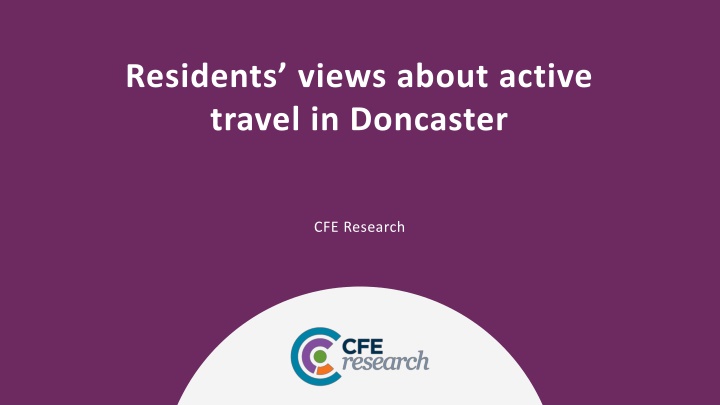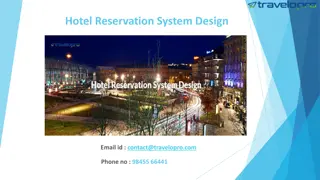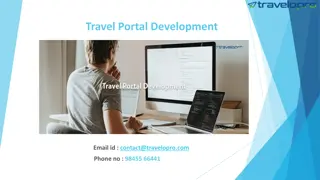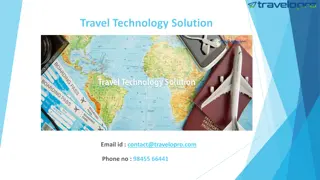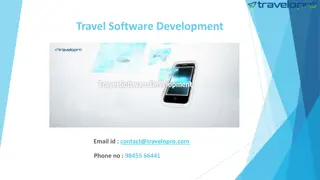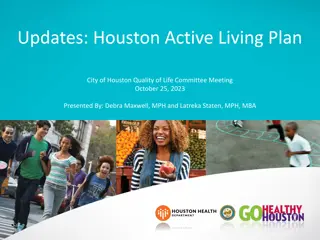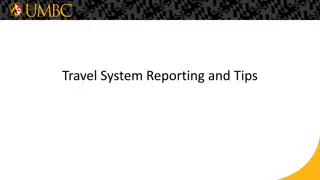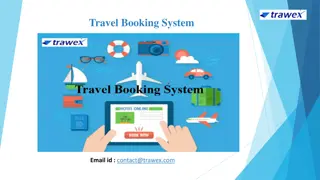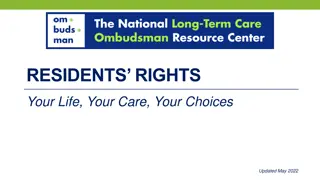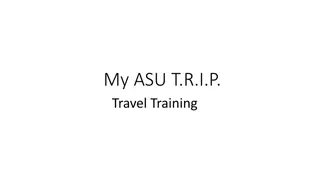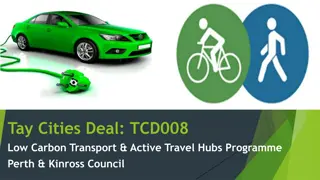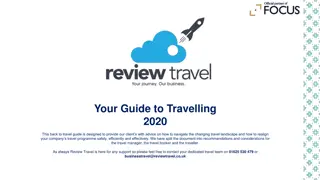Insights from Residents on Active Travel in Doncaster
This report highlights findings from a survey on active travel in Doncaster, covering respondent demographics, levels of active travel, influencing factors, preferred transport methods, perceptions, future plans, and key insights. Key findings include the age groups and employment status of respondents, household compositions, physical activity levels, and the proportion of residents engaging in active travel in the last 3 months. The survey data provides valuable insights for promoting active travel initiatives and improving community well-being.
Download Presentation

Please find below an Image/Link to download the presentation.
The content on the website is provided AS IS for your information and personal use only. It may not be sold, licensed, or shared on other websites without obtaining consent from the author.If you encounter any issues during the download, it is possible that the publisher has removed the file from their server.
You are allowed to download the files provided on this website for personal or commercial use, subject to the condition that they are used lawfully. All files are the property of their respective owners.
The content on the website is provided AS IS for your information and personal use only. It may not be sold, licensed, or shared on other websites without obtaining consent from the author.
E N D
Presentation Transcript
Residents views about active travel in Doncaster CFE Research
Contents These slides contain the findings from the Residents Panel survey conducted in July 2021. The survey was completed by 146 residents. The findings cover: The characteristics of those responding to the survey Active travel levels amongst residents in the last 3 months compared to the period between January to March 2021 Influencing factors for active travel Where residents actively travel to Impact of active travel Preferred methods of transport Perceptions about physical activity and active travel Residents future plans for physical activity for travel and leisure Key insights from the survey
Demographic characteristics
Demographics of respondents Age Number of respondents Disability Number of respondents 16-24 13 No disability, mental health or illness 82 25-44 62 Yes, but no substantial impact on daily life 25 45-64 48 Yes, has substantial impact on daily life 38 65+ 23 Prefer not to say 1 Main employment status Number of respondents Gender Number of respondents 45 Employee full-time Male 49 24 Employee part-time 10 Female 97 Self-employed 24 Retired 10 Ethnicity Number of respondents Unemployed and seeking work 7 Student White British 132 11 Not in work and looking after home or family BAME 14 15 Long-term sick Other economic activity 0
Demographics of respondents Household composition Number of respondents Income Number of respondents One or more adults, no children 86 Low income 68 One adult with one or more children aged under 18 Other income 69 Two or more adults with one or more children aged under 42 Unknown 9 In an Active Number of respondents Communities area Yes 46 No 100 Physical activity level when joined the panel Number of respondents Physically inactive 39 Physically active at least once a week 107
Active travel in the last 3 months
Residents active travel in the last 3 months More residents have walked, jogged or run, and have done so more regularly, compared with cycling: - 8 in 10 (81%) residents have undertaken a short walk, jog or run to travel somewhere compared to just 2 in 10 (20%) for cycling. In addition, over 3 in 10 (35%) have undertaken a short walk, jog or run at least 4 times a week compared with just 3% for cycling. - 7 in 10 (73%) residents have undertaken a longer walk, jog or run to travel somewhere compared with just 2 in 10 (17%) for cycling and again they do it more regularly. Proportion undertaking activity Rates are similar to those reported by residents in the August 2020 active travel poll. Walk, jog or run for fun or leisure 23% 5% 5% 5% 30% 31% 77% A short walk, jog or run to travel somewhere (less than 20 minutes) 19% 3% 8% 5% 29% 36% 81% A longer walk, jog or run to travel somewhere (20 minutes or more) 25% 6% 14% 10% 26% 18% 73% Bike ride for fun, leisure or sport 77% 3% 3% 4% 8% 3% 22% A short bike ride to travel somewhere (less than 20 minutes) 79% 4% 3% 8% 3% 20% A longer bike ride to travel somewhere (20 minutes or more) 82% 5% 3% 5% 3% 17% Not at all At least once a week At least once in the last 3 months At least 4 times a week At least once a month Don t know At least once a fortnight Q1. In the last 3 months, how often did you do the following? N=146
Comparing active travel over the last 3 months with the period January to March 2021 Over 7 in 10 (75%) residents had not undertaken a bike ride to travel somewhere across both periods of time, compared with just 2 in 10 (18%) residents who had not walked, jogged or run for travel purposes. Increases in active travel between the two time periods were more frequent for walking, jogging or running (27%) when compared to cycling (5%). - More active community residents (49%) had increased the amount of walking, running or jogging they had done for travel in the last 3 months compared with non active community residents (28%). Although increases were more common, some had decreased the amount they actively travelled. A walk, jog or run to travel somewhere 18% 17% 35% 27% 3% A bike ride to travel somewhere 75% 8% 6% 5% 5% I have done none during both periods I have done less or stopped I have done the same I have done more or started Don t know Q1. Reflecting on walking, jogging, running or cycling as a means of transport, how does the amount you undertook in the last 3 months compare to the period January to March 2021? N=146
Influencing factors for walking, jogging and running for travel
What influenced residents to maintain or increase walking, jogging or running for travel? To keep fit and healthy 56% Keeping fit and healthy (56%) and because they enjoy it (48%) are the primary reasons that residents have maintained or increased the amount they walk, jog or run for travel in the last 3 months. I enjoy it 48% It is a convenient way to get to places 32% I have more time to get to places by myself 17% 3 in 10 residents have maintained or increased this behaviour because it is convenient and approximately 2 in 10 have done so because they have more time to get to places (17%) and to help maintain social distancing due to the COVID-19 pandemic (16%). To help maintain social distancing due to the COVID-19 pandemic 16% It is more cost effective 14% There are no alternatives available to me 11% I have more time to get to places with my family 10% There being no alternatives available is only a reason for a small proportion of residents alongside it being more cost effective; therefore, most are choosing this as a method of travel. To support the environment 9% The local footpaths and amenities support this 8% Other 10% Don t know 3% Q3. What are the main reasons you have increased or maintained the amount of walking, jogging or running to travel somewhere in the last 3 months? N=90
What influenced residents to decrease walking, jogging or running for travel? I am unable to because of health concerns, illness or disability Of the small proportion who had decreased the amount of walking they do for travel 8 residents stated they did so because of health concerns, illness or disability; and 8 did so because they had lost their motivation. 8 I have lost my motivation 8 I do not have the time that I did to get to places by myself 4 I do not have the time that I did to get to places with my family 3 No participants reduced this behaviour because they no longer enjoy walking, jogging or running for travel. It is no longer a convenient way to get to places 2 The local footpaths and amenities hinder this 2 I feel comfortable using alternate modes of transport now that lock down is lifted 1 I no longer feel safe now that traffic levels have increased due to the easing of COVID-19 restrictions 1 I no longer enjoy it 0 Other 2 Don t know 1 Q4. What are the main reasons you have decreased the amount of walking, jogging or running to travel somewhere in the last 3 months? N=25
Why have some residents undertaken no walking, jogging or running for travel since January 2021? Of the small proportion who had undertaken no walking most (13) had not done so because of health concerns, illness or disability. I am unable to because of health concerns, illness or disability 13 It is not a convenient way to get to places 5 5 stated they did not think it was a convenient mode of transport and 4 had not done so because they did not want to/prefer alternative modes of transport. I do not wish to walk for travel purposes/prefer alternate modes of transport 4 I do not have time to get to places with my family 1 Don t know 2 Q5. What are the main reasons you have undertaken no walking, jogging or running to travel somewhere since January 2021? N=21
Influencing factors for cycling for travel
What influenced residents to maintain or increase cycling for travel? To keep fit and healthy 11 Only 15 residents had maintained or increased the amount of cycling they had done for travel in the last 3 months (due to the low levels reported overall). I enjoy it 7 It is more cost effective 6 It is a convenient way to get to places The most common reason was because they wanted to keep fit and healthy. 6 To support the environment 4 Enjoying it, because it s more cost effective, and because it is a convenient way to get to places were also the more common reasons for doing so. There are no alternatives available to me 3 The local cycle lanes and amenities support this 3 I have more time to get to places by myself 3 To help maintain social distancing due to the COVID-19 pandemic 2 I have more time to get to places with my family 2 Q6. What are the main reasons you have increased or maintained the amount cycling to travel somewhere in the last 3 months? N=25
What influenced residents to decrease cycling for travel? Of the low number of residents who reported a decrease not having the time that they did between January to March 21, and no longer owning or having access to a bike were the most common reasons. I do not have the time that I did to get to places by myself 5 I no longer own or have access to a bike 5 I feel comfortable using alternate modes of transport now that lock down is lifted 2 I do not have the time that I did to get to places with my family 2 As with walking, jogging or running for travel, no residents had reduced their cycling for active travel because they no longer enjoy it. I have lost my motivation 2 I am unable to because of health concerns, illness or disability 1 I no longer enjoy it 0 Other 2 Q7. What are the main reasons you have decreased the amount of cycling to travel somewhere in the last 3 months? N=12
Why have some residents undertaken no cycling for travel since January 2021? The most common reason for residents not cycling anywhere to travel, is because they do not own or have access to a bike, (53%). I do not own or have access to a bike 53% I am unable to because of health concerns, illness or disability 29% 3 in 10 (29%) residents have not done so because of health concerns, illness of disability. I am unable to ride a bike 13% I do not wish to cycle for travel purposes/prefer alternate modes of transport 12% Just over 1 in 10 (13%) are unable to ride a bike. It is not a convenient way to get to places 7% The local cycle paths and amenities hinder this 3% I do not have time to get to places by myself 1% 3% Don t know Other 2% Q8. What are the main reasons you have undertaken no cycling to travel somewhere since January 2021? N=94
Where are residents travelling to when undertaking active travel?
Where residents have travelled to when walking, jogging or running Residents are most likely to have walked, jogged or run to the shops in the last 3 months this has increased from 56% to 76%. Many also walk to a park or outdoor space and to the homes of friends and family. To the shops 76% 56% To a park or outdoor space 70% 54% The homes of my friends and family 48% 36% My place of work or school/college 29% 24% To take my children to school 29% 18% Other 19% 9% In the last 3 months January to March 2021 Q9. Where did you walk, jog or run in the period between January to March 2021 and in the last 3 months?
Where residents have travelled to when walking, jogging or running Residents who have walked, jogged or run for travel purposes more over the last 3 months, are now more commonly doing so for various reasons such as going to the park, shops, to visit friends and family or take children to school. Q9. Where did you walk, jog or run in the period between January to March 2021 and in the last 3 months?
Where residents have travelled to when cycling Across all 3 groups, residents most commonly cycled to shops, parks or outdoor spaces and to the homes of their family and friends. To the shops 11 17 To a park or outdoor space 15 17 The homes of my friends or family 11 16 My place of work or school/college 8 13 To take my children to school 6 8 Other 1 2 January to March 2021 In the last 3 months Q10. Where did you cycle in the period between January to March 2021 and in the last 3 months?
Where residents have travelled to when cycling Given the group sizes, the patterns here are slightly less clear when split by the change in frequency. Residents who have cycled more in the last 3 months, have generally increased the variety of places they are cycling to with the shops, the park, friends and family, and work/school or college featuring. Q10. Where did you cycle in the period between January to March 2021 and in the last 3 months?
Impact of active travel on residents
Impact of walking, jogging and running for travel Encouragingly, those who have walked, jogged or run more for travel in the last 3 months have experienced a range of positive impacts as a result of doing so. This is similar for those who have done the same amount. Those who have done less, generally report that it has had either a negative impact or no impact. Interestingly, over half of these residents report a positive impact on their appreciation of parks and open spaces and their attitude towards encouraging their own children/grandchildren to be active. Q11. How has undertaking more/the same amount of/less walking, jogging or running to travel somewhere affected you?
Impact of cycling for travel Again, those who cycled more or maintained their levels in the last 3 months have experienced a range of positive impacts. Those who have done less, generally report that it has had either a negative impact or no impact. Again, approximately half of these residents report a positive impact on their appreciation of parks and open spaces and their attitude towards encouraging their own children/grandchildren to be active. Q11. How has undertaking more/the same amount of/less cycling to travel somewhere affected you?
Preferred modes of transport
Residents preferred modes of transport Residents attitudes towards different modes of transport have changed since the COVID-19 pandemic. 69% By car 69% 47% Encouragingly, 6 in 10 residents (61%) now prefer to travel by foot (walking) compared with 5 in 10 (47%) before the pandemic. Walking 61% 42% By bus 21% Only approximately 2 in 10 residents prefer to travel by bus (21%) or train (16%) now, compared with 4 in 10 before the pandemic (42% and 37%, respectively). 37% By train 16% 16% By bicycle 14% However, travelling by car was the most common preferred mode of transport and still is. 8% By motorbike or moped 3% Travelling by bike is still not a preferred mode of transport for many residents. Before the COVID-19 pandemic Now Q12. What were your preferred ways of travelling to reach places before the COVID-19 pandemic and what are they now? N=146
Perceptions about active travel
Motivators of active travel Being physically active is important for over 7 in 10 (76%) residents, and over 6 in 10 (64%) enjoy active travel. - More active community residents (24%) strongly disagree (providing a score of 0-2) that they enjoy walking, jogging or running for leisure compared with non active community residents (9%). In addition, fewer active community residents (29%) strongly agree (providing a score of 8-10) that being physically active is important to them compared with non active community residents (54%). Encouragingly, over 7 in 10 (73%) of residents believe individuals have a responsibility to make greener transport choices in their daily lives, and 5 in 10 (51%) think they need to undertake active travel more to benefit the environment. Proportion agreeing Being physically active is important to me (n=144) 7% 15% 30% 46% 76% As individuals we have a responsibility to make greener transport choices in our daily lives (n=144) 5% 7% 15% 18% 55% 73% I enjoy walking, jogging, running or cycling for leisure (n=146) 14% 6% 16% 21% 43% 64% I need to walk, jog, run or cycle more to reach places to benefit the environment (n=143) 18% 10% 21% 20% 31% 51% I walk, jog, run or cycle to reach places because I have to (n=142) 44% 13% 18% 11% 14% 25% 0-2 3-4 5 6-7 8-10 Q13. To what extent do you agree or disagree with the following statements about walking, jogging, running or cycling to travel somewhere?
Barriers to active travel Almost 8 in 10 (77%) residents agree that convenience is the main factor when considering how they travel to reach places. Over 7 in 10 (75%) agree that they are more likely to actively travel when the weather is better. Interestingly, over 5 in 10 (56%) residents agree that they lack confidence on a bike. - More females (45%) strongly agree (providing a score between 8-10) than males (25%). 4 in 10 (43%) residents agree they are not motivated to undertake active travel. - More active community residents (36%) strongly agree (providing a score between 8-10) compared with non active community residents (19%). Over 2 in 10 (23%) residents agree that nothing would encourage them to undertake active travel (although some do currently actively travel whilst others have health problems which prevent them). Proportion agreeing Convenience is the main factor that I consider when selecting how I travel to reach places (n=146) 5% 4% 13% 18% 60% 77% I am more likely to walk, jog, run or cycle to reach somewhere when the weather is better (n=146) 10% 3% 12% 21% 54% 75% I am physically able to walk, jog, run or cycle to travel somewhere (n=146) 16% 6% 8% 17% 53% 71% I lack confidence on a bike (n=142) 25% 7% 11% 18% 38% 56% The distances I travel mean that walking, jogging, running or cycling to reach somewhere are not an option (n=138) 20% 12% 18% 16% 35% 51% I am not motivated to walk, jog, run or cycle to reach somewhere (n=143) 28% 13% 17% 18% 24% 43% The car is the only real option available for me (n=144) 27% 8% 23% 17% 26% 42% Walking, jogging, running or cycling to reach somewhere does not fit with my family commitments (n=141) 28% 12% 23% 16% 22% 38% Nothing would encourage me to walk, jog, run or cycle to reach somewhere (n=143) 45% 11% 20% 7% 16% 23% 0-2 3-4 5 6-7 8-10 Q13. To what extent do you agree or disagree with the following statements about walking, jogging, running or cycling to travel somewhere?
Infrastructure for active travel Over 7 in 10 (71%) residents agree that improving the walking and cycling environment should be a priority in Doncaster. Over 6 in 10 (65%) residents agree that roads in Doncaster are too dangerous to cycling and over 5 in 10 (54%) residents agree that pavements and walking environments in Doncaster are inadequate. Just under 5 in 10 (49%) residents agree that public transport networks in Doncaster are fit for purpose. Proportion agreeing Improving the walking and cycling environment (e.g. footpaths and cycle lanes) should be a priority in Doncaster (n=143) 6% 6% 18% 20% 51% 71% The roads in Doncaster are too dangerous for cycling (n=131) 7% 5% 24% 21% 44% 65% The pavements and walking environment (e.g. pedestrian crossings) in Doncaster are inadequate (n=143) 10% 13% 22% 24% 29% 54% Public transport networks in Doncaster are fit for purpose (n=131) 14% 21% 17% 24% 24% 49% 0-2 3-4 5 6-7 8-10 Q13. To what extent do you agree or disagree with the following statements about walking, jogging, running or cycling to travel somewhere?
Residents plans for active travel and leisure/sport Residents are overwhelmingly more likely to walk, jog or run for active travel or leisure in the next 3 months than they are to cycle reflecting their previous habits. Despite a high proportion of residents definitely or possibly planning to undertake a walk, jog or run for active travel of leisure purposes, more residents in activity communities do not intend to do these things: - 22% of active community residents do not intend to undertake a short walk, jog or run for travel compared with 7% of non active community residents. - 35% of active community residents do not intend to undertake a longer walk, jog or run for travel compared with 19%. - 26% of active community residents do not intend to walk, jog or run for leisure compared with 11%. Proportion planning to do activity Walk, jog or run for fun or leisure 10% 16% 21% 53% 75% A short walk, jog or run to travel somewhere (less than 20 minutes) 5% 12% 29% 54% 83% A longer walk, jog or run to travel somewhere (20 minutes or more) 10% 24% 25% 41% 66% Bike ride for fun, leisure or sport 12% 60% 13% 15% 28% A short bike ride to travel somewhere (less than 20 minutes) 13% 60% 14% 13% 27% A longer bike ride to travel somewhere (20 minutes or more) 12% 63% 16% 10% 25% Don t know Not at all Yes, possibly Yes, definitely Q14. In the next 3 months, do you intend to do any of the following? N=146
So, what does this mean? Residents in Doncaster are more likely to walk, jog or run for both active travel and leisure than they are to cycle. Levels of active travel have remained similar to those reported in august last year. Most residents have a positive attitude towards being physically active but not all. They agree it is important to them, they enjoy it and they also think that individuals have a responsibility to make greener transport choices in their daily lives. However, residents from active communities enjoy it less, it is less important to them and they are less motivated to do it. In the last 3 months, almost 3 in 10 residents have increased the amount of walking, jogging or running they have done to travel, which was mainly to help them keep fit and healthy and because they enjoy it. Encouragingly, there was a greater increase amongst active community residents. However, over 8 in 10 residents have undertaken no cycling for travel since January 2021. The main reasons for this are because residents do not own or have access to a bike; because of health concerns, illness or disability; or because they are unable to ride a bike. Residents have most commonly actively travelled in the last 3 months to go to the shops, visit a park or outdoor space, or visit the homes of their friends and families. These trends were also the same for the period between January to March 2021, but fewer residents reported doing so. Residents who have increased their active travel in the last 3 months are now undertaking active travel for a wider variety of reasons than those who have maintained their activity or those who have reduced it. For example, they are now also undertaking more active travel to go to the shop, get to work or school/college, and to take their children to school more so than those who have maintained their active travel levels or those who are doing less. These changes align with changes to COVID-19 restrictions. Active travel to parks has also increased, which reflects the increase in parks usage seen in the previous survey. Encouragingly, this supports the findings that residents commonly travel by foot.
So, what does this mean? Residents who have increased or maintained the amount of active travel in the last 3 months report a range of positive impacts. Whereas residents who have undertaken less, report more negative impacts. However, residents who have done less report a positive impact on their appreciation of parks and open spaces, and their attitude towards encouraging their own children/grandchildren to be active this suggests that their reduction in active travel has highlighted some of the benefits they have missed out on. Encouragingly, more residents prefer to travel by foot now than they did prior to the pandemic, which is reflected in their plans for travelling by foot the future. They are less likely to state the bus or train but their views on travelling by car are unchanged. This suggests it is those who use public transport primarily account for this change. Convenience and the distance residents sometimes travel prevent them from actively travelling. Although there was a greater increase in the proportion of active community residents who had undertaken walking, jogging or running to travel somewhere in the last 3 months, more of these residents do not intend to do so in the future than non active community residents. This suggests that more needs to be done with these groups to encourage them to engage in active travel. Travelling by bike is still only a preferred method of transport for a minority of residents, which is also reflected in their plans for travelling by bike in the future. Ownership or access to a bike, and having the ability to ride a bike are barriers for some residents. However, over 6 in 10 also agree that the roads in Doncaster are too dangerous for cycling, and 7 in 10 agree that improvements to the walking and cycling environment should be a priority. These findings suggest that overcoming these challenges may encourage more people to cycle for travel.
